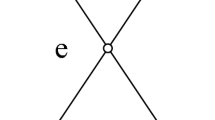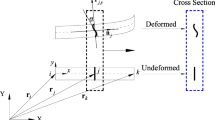Abstract
Because the deployable structures are complex multi-loop structures and methods of derivation which lead to simpler kinematic and dynamic equations of motion are the subject of research effort, the kinematics and dynamics of deployable structures with scissor-like-elements are presented based on screw theory and the principle of virtual work respectively. According to the geometric characteristic of the deployable structure examined, the basic structural unit is the common scissor-like-element(SLE). First, a spatial deployable structure, comprised of three SLEs, is defined, and the constraint topology graph is obtained. The equations of motion are then derived based on screw theory and the geometric nature of scissor elements. Second, to develop the dynamics of the whole deployable structure, the local coordinates of the SLEs and the Jacobian matrices of the center of mass of the deployable structure are derived. Then, the equivalent forces are assembled and added in the equations of motion based on the principle of virtual work. Finally, dynamic behavior and unfolded process of the deployable structure are simulated. Its figures of velocity, acceleration and input torque are obtained based on the simulate results. Screw theory not only provides an efficient solution formulation and theory guidance for complex multi-closed loop deployable structures, but also extends the method to solve dynamics of deployable structures. As an efficient mathematical tool, the simper equations of motion are derived based on screw theory.
Similar content being viewed by others
References
BALL R S. A treatise on the theory of screw[M]. Cambridge: Cambridge University Press, 1900.
HUNT K H. Kinematic geometry of mechanisms[M]. London: Oxford University Press, 1978.
MARTÍNEZ J M R, DUFFY J. An application of screw algebra to the acceleration analysis of serial chains[J]. Mechanism and Machine Theory, 1996, 31(4): 445–457.
RICO J M, GALLARDO J, DUFFY J. Screw theory and higher order kinematic analysis of open serial and closed chains[J]. Mechanism and Machine Theory, 1999, (34): 559–586.
GALLARDO J, RICO-MARTINEZ J M, ALICI G. Kinematics and singularity analyses of a 4-DOF parallel manipulator using screw theory[J]. Mechanism and Machine Theory, 2006, 41(9): 1048–1061.
GALLARDO J, OROZCO-MENDOZA H, RODRÍGUEZ R C, et al. Kinematics of a class of parallel manipulators which generates structures with three[J]. Multibody Syst Dynamics, 2007, 17: 27–46.
GALLARDO J, AGUILAR C R, CASIQUE L, et al. Kinematics and dynamics of 2(3-RPS) manipulators by means of screw theory and the principle of virtual work[J]. Mechanism and Machine Theory, 2008, 43(10): 1281–1294.
RICO J M, CERVANTES J J, GALLARDO J, et al. Velocity and acceleration analysis of lower mobility platforms via screw theory[C]//32nd Annual Mechanisms and Robotics Conference, Volume 2, Parts A & B. Brooklyn, New York, USA, August 3–6, 2008: 1313–1324.
JOSHI S A, TSAI L W. Jacobian analysis of limited-DOF parallel manipulators[J]. Journal of Mechanical Design, 2002, 124(2): 254–258.
ZHU S J, HUANG Z, GUO X J. Forward/reverse velocity and acceleration analyses for a class of lower-mobility parallel mechanisms[C]//Proceedings of the ASME International Design Engineering Technical Conferences and Computers and Information in Engineering Conference, Volume 7, Parts A and B. Long Beach, California, USA, September 24–28, 2005: 949–955.
ZHU S J, HUANG Z, DING H F. Forward/reverse velocity and acceleration analysis for a class of lower-mobility parallel mechanisms[J]. Journal of Mechanical Design, 2007, 129(4): 390–396.
LIU H T, HUANG T, CHETWYND D G. An approach for acceleration analysis of lower mobility parallel manipulators[J]. Journal of Mechanisms and Robotics-Transactions of the ASME, 2011, 3(0110131).
HUANG Z, ZHU S J. Kinematic analyses of 5-DOF 3-RCRR parallel mechanism[C]//Proceedings of the ASME International Design Engineering Technical Conferences and Computers and Information in Engineering Conference, Volume 7, Parts A and B. Long Beach, California, USA, September 24–28, 2005: 993–999.
TSAI L W. Robot analysis: the mechanics of serial and parallel manipulators[M]. John Wiley & Sons, Inc., 1999.
TIAN Z X, WU H T. Spatial operator algebra for free-floating space robot modeling and simulation[J]. Chinese Journal of Mechanical Engineering, 2010, 23(5): 635–640.
MURRAY R M, LI Z, SASTRY S S. A mathematical introduction to robotic manipulation[M]. CRC Press, 1994.
SANG H Q, HE C, LI J M, et al. Dynamic modeling and trajectory tracking control for a 3-DOF instrument in minimally invasive surgery[C]//IEEE International Conference on Robotics and Biomimetics, Volume 1–4. Guilin, China, December 19–23, 2009: 331–336.
TSAI L W. Solving the inverse dynamics of a Stewart-Gough manipulator by the principle of virtual work[J]. Journal of Mechanical Design. 2000, 122(1): 3–9.
HUANG Y, LIAO Q, WEI S, LEI G. Research on dynamics of a bicycle robot with front-wheel drive by using Kane equations based on screw theory[C]//2010 International Conference on Artificial Intelligence and Computational Intelligence. Sanya, China, Oct 23–24, 2010: 546–551.
CHEN W J, FU G Y, GONG J H, et al. Dynamic deployment simulation for pantographic deployable masts[J]. Mechanics of Structures and Machines, 2002, 30(2): 249–277.
HU M, CHEN C, PAN J, et al. Dynamics analysis on deployment for the multi-deployment lock solar array[C]//2010 International Conference on E-Product E-Service and E-Entertainment(ICEEE). Henan, China: IEEE Computer Society, Nov 7–9. 2010: 1–5.
ZHAO J S, DAI J S. WANG J Y, et al. Mechanism synthesis of a foldable stair[J]. Journal of Mechanisms and Robotics-Transactions of the ASME, 2012, 4(0145021).
SUN Y T, WANG S M, LI J F, et al. Mobility analysis of the deployable structure of SLE based on screw theory[J]. Chinese Journal of Mechanical Engineering, 2013(4): 793–800.
HUANG Z, ZHAO Y, ZHAO T. Advanced spatial mechanism[M]. Beijing: Higher Education Press, 2006. (in Chinese)
LIU J, LI Y, HUANG Z. Mobility analysis of altman over-constrained linkages by modified Grübler-Kutzbach criterion[J]. Chinese Journal of Mechanical Engineering, 2011, 24(4): 638–646.
Author information
Authors and Affiliations
Corresponding author
Additional information
Supported by National Natural Science Foundation of China(Grant No. 51175422)
SUN Yuantao, born in 1985, is currently a PhD candidate at School of Mechanical Engineering, Northwestern Polytechnical University, China. His main research internets include space deployable structure and multi-bodies systems dynamics.
WANG Sanmin, born in 1961, is a professor at School of Mechanical Engineering, Northwestern Polytechnical University, China. His research interests include mechanism, mechanical vibration and control and mechanical dynamics.
MILLS James K, is a professor at Mechanical & Industrial Engineering, University of Toronto. His research interests include robot control, control of multi-robots, design of actuators, localization, development of fixtureless assembly technology, design and control of high speed machines.
ZHI Changjian, born in 1984, is a PhD candidate at School of Mechanical Engineering, Northwestern Polytechnical University, China.
Rights and permissions
About this article
Cite this article
Sun, Y., Wang, S., Mills, J.K. et al. Kinematics and dynamics of deployable structures with scissor-like-elements based on screw theory. Chin. J. Mech. Eng. 27, 655–662 (2014). https://doi.org/10.3901/CJME.2014.0519.098
Received:
Revised:
Accepted:
Published:
Issue Date:
DOI: https://doi.org/10.3901/CJME.2014.0519.098




